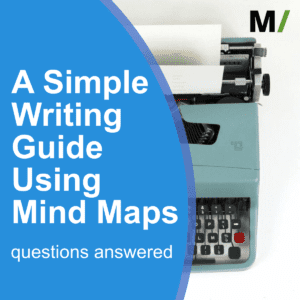Writing an article, dissertation, blog post or another piece of content should be easy. You should be focussing on delivering the right message. Unfortunately, many people find it hard to create something that is clear and delivers value.
In this article, I want to offer you a solution to make writing easier and more to the point.
7 Easy Steps to Create an Article in Under One Hour Without Stress
Below are the 7 steps you can use to create your next piece of content.
1.
Write the title in the center of the map
We start by adding the title of our piece to the center of the mind map that we are creating.
Don’t worry if you don’t have any mind mapping software. Here are some links to download your own mind mapping tool.
(If you like to know how each of these tools work, please let me know so I can add a short tutorial)
To find a title, headline or topic to write about is something that is right now beyond the scope of this article. There are countless books about headlines written. I assume you have already a pretty good idea about what you want to write.
In case you don’t have a headline in mind, you can have a look at these resources that will help you create one:
Headline hacks by Jon Morrow
The Step-by-Step Guide to Writing Powerful Headlines by Neal Patel
Kickass Headline Generator by Sumo.com
Also, writing the headline may even be the last thing you do when writing.
I have often found it easier to write first, and when the piece is ready, I look at the text and find a title for what I created.

Great, now that you have your headline or a big X in the middle, we continue to the second step.
2.
Add these 4 branches to the map
The goal is to create a piece that is helping the reader understand, convince, and perhaps implement something.
To do this best, we add 4 branches to the map:
1. What (is it that you have)
2. Why (is it important to know, understand, do, have this)
3. How (do I get this or implement it, what are the X steps to follow)
4. What if (I get stuck and need more information)
Let’s see this in action when looking at this step. Here we go:

WHAT: As you can see, there are 4 steps a writer can use to guide a reader from being a beginner to a person who can move forward.
WHY: The reason we work this way is because it addresses different styles of learning. Some people want to know why they have to do something. Others need facts,theories, and numbers to be convinced. People love to see what they can do to implement or use a technique or idea. And once you did what was explained, and you get stuck… there is more coaching in the fourth step.
Also, using a system for writing helps you the writer to focus more on the writing 🙂
HOW: By using all four, we can serve our audience the best way possible.
WHAT IF: Of course everybody can use this system. But there may be moments when using it is difficult or even not possible. If that is the case, skip that step. Perhaps you don’t need a step-by-step implementation in your article. Then don’t use it. You are free to use it any way you like!
NOTE: this WHY, WHAT, HOW, WHAT IF approach is something you can use for more than just the first level of your mind map/writing.
You can also use these same ideas for each lower-level branch. Have a look at the branch to see if this is possible.
Most of the time you only use this approach in the HOW section of the article, where you list the steps or ideas. Still, you can try to use it at the other parts of the article as well!
3.
Add Bullet Points to Each Branch
This is where you start moving into each part of the article.
Under each one, write 3 to 7 bullet points that you feel are explaining your point.
For example, I included under WHY ideas like:
4.
Write the First Level Subheadings
Once you know what you are writing about in each branch, you can find a sub-headline that serves as the title of each subsection. These are the WHY, WHAT, HOW, WHAT IF that we first wrote in the map.
Again, you can use the headline guides mentioned above for this. Make sure the headline is catching attention and specific! Here is the updated map:
Expand the Bullet Points
After this, you go into the actual writing! (FINALLY ;))
This is how you do this.
You click on a bullet point. Next, you open the NOTES SECTION of your tool. For example, in XMind, this is the F4 key.
Once you click this, you will see another small window. In this window, you can add your text. Make it relevant to the reader and the sub-headline you picked.
Write something that is to the point. Don’t write too much. A few lines might be enough. After all, you may have 30 or 40 bullet points throughout the entire map. Just 3 lines per bullet point may give you an article of 1000 to 2000 words!!!
If you feel it is difficult to write something, you can use the WHY, WHAT, HOW & WHAT IF method again for each bullet.
That is right… you can create a list of things to do for each bullet 🙂
Just like I did for the headline ideas/list under bullet 1!
When you feel you wrote enough, it is time to move on to the next bullet. Make a nice transition to keep the flow of the writing. Something like…
After you wrote the bullets and you finished the article, it is time to create the full article. This is done by…
6.
Exporting to MS WORD
This is probably one of the easiest things to do.
You take your finished map… and you export it to MS WORD.
In XMind you do this by going into the menu to FILE and choosing EXPORT, and DOCUMENT.
The result of doing this is a document with headlines, subheadings, and paragraphs of text.
The next thing is that you probably add some images and perhaps color… and you are good to go!!!
You did it!
It is time to… (see what I am doing here 😉 )
7.
Congratulate Yourself
Yes, you MUST congratulate yourself on this result. You took your idea, and you converted it into something that other people can use to move forward in life.
– Make a little victory dance.
– If you like, let a friend read and comment on it.
– Share the article with other people.
And after that… move on to the next piece.
3 Problems Holding You Back From Writing Your Next Big Piece
Like I wrote before, this is the little bit of “coaching” that will help your readers move forward even when they get stuck.
Think of 3 problems they may experience when going through your steps/ideas/content. Add them to your text with a solution to solve that problem. Something like this:
Problem 1: What if I don’t have any software to use?
Download a tool from the software page. Use another tool when you don’t like these. Make sure you have the option to export to MS WORD!
If you have questions about using the tool, contact me. I can always help you out.
Problem 2: What if I still can’t find the right headlines?
The pages provided above are very good ones. You can use these quick tips to make your headline look better:
– add numbers (like… the 5 steps to, or have 25% more readers by doing…)
– add timeframes (like … in 3 minutes, or …in 30 days)
– use simple words (like getting instead of acquiring)
– and think about what your audience would like (fancy or practical words…)
Problem 3: What if I don’t have enough bullet points?
If you write something for your audience, and you explain in detail what can and should be done, you probably have enough bullet points. You may even have too many!!!
Imagine you are in a bar and you have to explain your story/topic to a person you’ve just met. How many steps or bullet points would you need?
There you go, some answers to questions you may have. Do you see what I am doing? I solved 3 problems people might have who want to write an article using a mind map.
Please note: You can use this approach with almost any kind of content writing. From a short 200 words blog post to a full 200-page dissertation. The content is different, but structure still remains to be structure 🙂
To Conclude and Summarize
Writing isn’t that hard when you have a system in place that will help you to write. It removes writers block for many people.
You don’t need to write one giant piece of text. You construct it using small steps to build your epic story.
Use the steps above in your own writing. Tweak when you like to. Don’t feel bound by it, use it to write.
You can add other structures if you like. Be flexible.
For now, let me know how this helps you and if you need any help from me. I am more than happy to help you out.
Enjoy writing your next piece!





